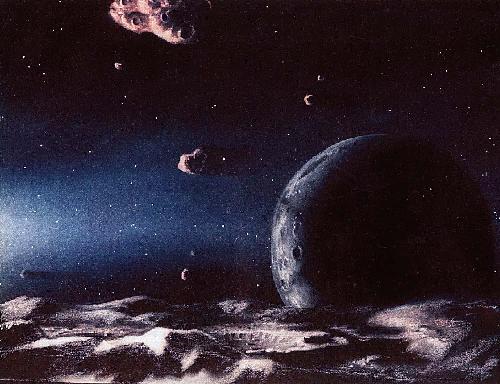| DISINTEGRATING ASTEROID P/2013 R3 |
|---|
Main-Belt Comets | Comet Home Page | Kuiper Belt Home Page | Paper 1 | Paper 2 | HST Press Release |
Summary
P/2013 R3 has an orbit near 3 AU, typical of many thousands of asteroids in the so-called "outer-asteroid belt", between Mars and Jupiter. But R3 does not look like any other asteroid; it is the first to show multiple components enshrouded in diffuse debris that has been spread by the pressure of sunlight. Our measurements show that this body is breaking up.
Caption: Active Asteroid/Main-belt comet P/2013 R3 imaged from the Hubble Space Telescope on four dates, as marked. Note the changes in the number, separations, brightnesses and positions of the fragments. These are caused partly by changes in the viewing geometry and partly by real changes in the object. On average, the components are separating at only about 0.5 meter/second, even as they orbit the Sun at 17 km/second. [Click on the image to see a larger version. Click here to see them animated in a Quicktime movie. ]
Possible Explanations
An explanation that cannot be rejected by the available observations is that the breakup was caused by rapid rotation leading to centripetal disruption. For this to happen, the precursor body would have to be very weak. Observations of other asteroids show that many or most are pre-fractured "rubble piles", caused by past impacts too small to cause disruption but large enough to inflict structural damage. It would thus not be surprising to find that R3 is very weak, with a rubble-pile type structure.
A related explanation was suggested earlier for 6-tailed asteroid
P/2013 P5. The difference in appearance may be because R3 is truly rotationally disrupted, whereas P5 was only in a 'mass-shedding' phase in which its particulate regolith fell off.
Rotational breakup may be an important mechanism for the destruction of small
asteroids, rivalling or surpassing impact destruction as the way asteroids die.
Main-Belt Comets
|
Comet Home Page
|
Kuiper Belt Home Page
|
Ap. J. paper
|
HST Press Release
|
Here are links to a
paper
in Astrophysical Journal Letters and another
paper
Astronomical Journal.
Here's a
popular article about R3.
David Jewitt
P/2013 R3 does not closely approach any planet or the Sun, so that tidal stresses cannot be responsible for breaking it apart.
The pieces were not all ejected at a single origin time suggesting that disruption by asteroid-asteroid impact is not the likely cause. Water ice sublimates weakly on R3, producing gas pressures that are too small even to fracture a pile of talcum powder. It is unlikely that ice sublimation is responsible for cracking the asteroid.
 |
 |
|
| Comet | Jewitt | Kuiper |
|---|